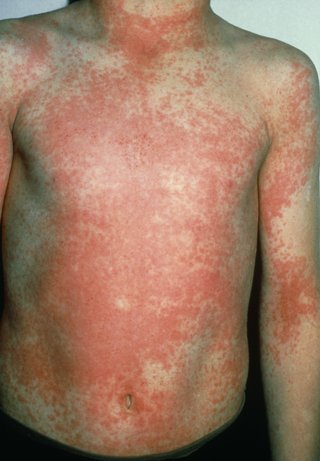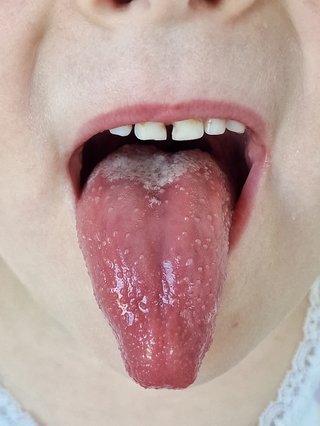Scarlet fever is a contagious infection that mostly affects young children. It is caused by the Group A streptococcus bacteria.
Scarlet fever can be easily treated with antibiotics.
Check if you have scarlet fever
The first signs of scarlet fever can be flu-like symptoms such as:
- high temperature (38 degrees Celsius or higher)
- sore throat
- swollen neck glands (a large lump on the side of your neck)
Most people with a high temperature or a sore throat have another virus and not scarlet fever.
A rash appears 12 to 48 hours later. It looks like small, raised bumps. It starts on the chest and tummy, then spreads. The rash makes your skin feel rough, like sandpaper.




The rash does not appear on the face, but the cheeks can look red. The redness may be harder to see on brown and black skin.
The symptoms are the same for children and adults, although scarlet fever is less common in adults.
Non-urgent advice: Contact your GP if you or your child:
- have scarlet fever symptoms
- have scarlet fever and chickenpox at the same time
- are ill again, weeks after scarlet fever got better - this can be a sign of a complication, such as rheumatic fever
- are feeling unwell and have been in contact with someone who has scarlet fever
Scarlet fever is very easily spread. Check with a GP before you go in. They may suggest a phone consultation.
What happens at your appointment
GPs can often diagnose scarlet fever by looking at your tongue and rash.
Sometimes they may:
- wipe a cotton bud around the back of your throat to test for bacteria
- arrange a blood test
If it's scarlet fever
If you or your child has scarlet fever, stay at home until all of these apply:
- You no longer have a high temperature.
- You don't have any other symptoms.
- It's been 24 hours since your first dose of antibiotics.
Treating scarlet fever
Your GP will prescribe antibiotics to treat the bacteria that causes scarlet fever.
These will:
- help you get better quicker
- reduce the chance of a serious illness, such as pneumonia
- make it less likely that you'll pass the infection on to someone else
Contact your GP if you or your child are showing no signs of improvement after taking antibiotics.
Taking antibiotics
Keep taking the antibiotics until they're finished, even if you feel better.
This will reduce the chance of the infection returning.
Things you can do yourself
You can relieve symptoms of scarlet fever by:
- drinking cool fluids
- eating soft foods if you have a sore throat
- taking painkillers like paracetamol to bring down a high temperature (do not give aspirin to children under 16)
How long scarlet fever lasts
Scarlet fever lasts for around 1 week.
You can spread scarlet fever to other people:
- up to 6 days before you get symptoms
- until 24 hours after you take your first dose of antibiotics
If you do not take antibiotics, you can spread the infection for 2 to 3 weeks after your symptoms start.
Risks and complications of scarlet fever
Scarlet fever can be a serious illness. But thanks to antibiotics, it's less common than it used to be and easier to treat.
Complications from scarlet fever are rare.
They can happen during or in the weeks after the infection, and can include:
- ear infection
- sepsis - know the signs of sepsis
- strep A
- throat abscess
- sinusitis
- pneumonia
- meningitis
- rheumatic fever
Pregnancy advice
There's no evidence to suggest that getting scarlet fever during pregnancy will harm your baby.
But it can make you feel unwell, so it's best to avoid close contact with anyone who has it.
Contact a GP if you get symptoms.
Many of the antibiotics used for scarlet fever are safe to take during pregnancy.
How to avoid spreading scarlet fever
Scarlet fever is very infectious and can easily spread to other people.
To reduce the chance of spreading scarlet fever:
Do
-
wash your hands often with soap and water
-
use tissues to trap germs from coughs or sneezes
-
bin used tissues as quickly as possible
-
complete your course of antibiotics if prescribed, even if you feel better (this reduces the chance of the infection returning)
Don't
-
do not go to work, school, creche or socialise with other people if you are ill
-
do not share cutlery, cups, towels, clothes, bedding or baths with anyone who has symptoms of scarlet fever
Content supplied by the NHS and adapted for Ireland by the HSE